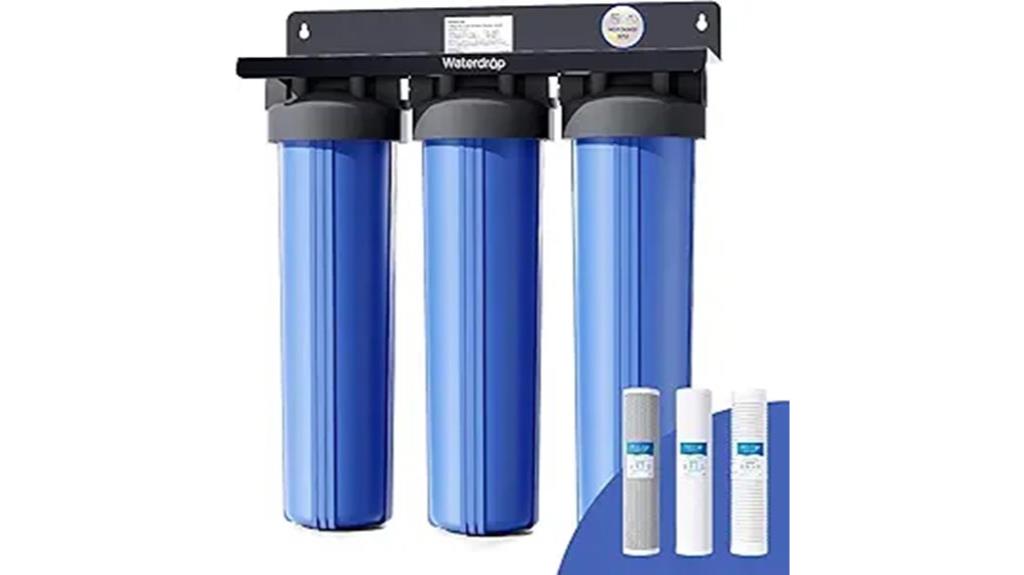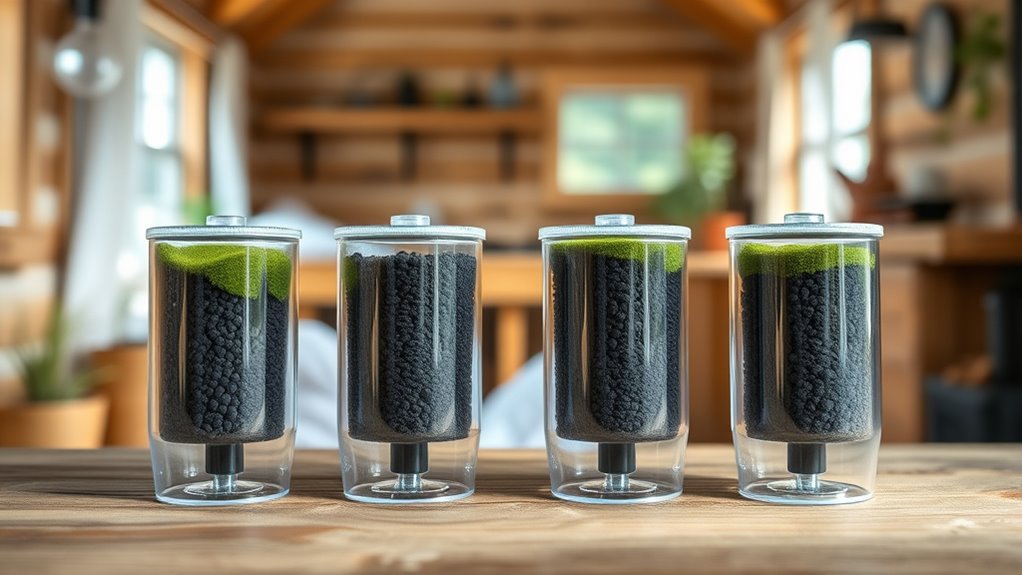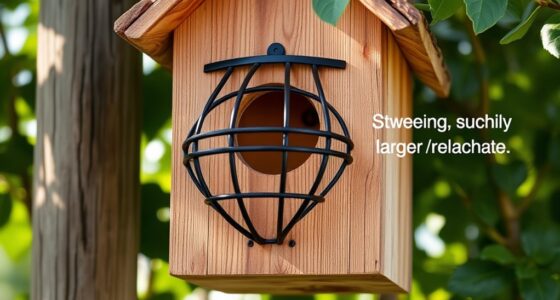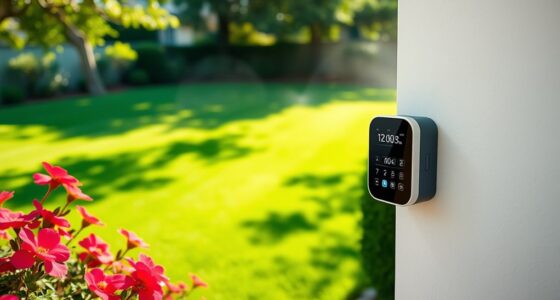If you’re looking for the best tiny house greywater filters in 2025, I recommend considering eco-friendly options like the ICEPURE 10X4.5 whole house filter, which removes over 99% of contaminants and lasts for six months. The WECO Tiny Series cartridges fit compact undersink systems and are easy to replace. The SimPure system offers durable, large-capacity filtration, while the Waterdrop 3-Stage system ensures high flow and multi-layer filtering. Keep reading to find the perfect fit for your tiny home.
Key Takeaways
- Choose filters with high sediment and organic matter removal capabilities suitable for greywater’s organic contaminants.
- Prioritize eco-friendly materials like coconut shell charcoal and BPA-free plastics for sustainable filtration.
- Ensure compatibility with standard 10X4.5-inch housings or existing greywater systems for seamless integration.
- Opt for durable, corrosion-resistant filters that require less frequent maintenance and support long-term eco-living.
- Select filters with longer lifespan and recyclable components to reduce waste and environmental impact in tiny homes.
ICEPURE 10X4.5 Whole House Water Filter 3-Pack

If you’re looking for a reliable filtration solution for your tiny house, the ICEPURE 10X4.5 Whole House Water Filter 3-Pack is an excellent choice. Certified by IAMPO and NSF/ANSI 42 rated, it reduces over 99% of chlorine, sediments, rust, and particles, greatly improving water taste. Made from natural coconut shell-activated carbon, it guarantees deep impurity removal and safety. With a lifespan of about six months or 30,000 gallons, it’s compatible with most standard filter housings. This durable, easy-to-install set provides consistent, clean water for your entire tiny home, supporting eco-friendly and healthy living.
Best For: those seeking a reliable, long-lasting whole house water filtration solution for small homes or tiny houses to ensure clean, great-tasting water.
Pros:
- Certified by IAMPO and rated to reduce over 99% of chlorine, sediments, rust, and particles, ensuring high water quality.
- Made from natural coconut shell-activated carbon for deep impurity removal and safety.
- Long-lasting with a recommended replacement every 6 months or 30,000 gallons, offering convenience and cost savings.
Cons:
- Compatibility limited to standard 10X4.5-inch filter housings, which may not fit all systems.
- Replacement frequency of every six months may be frequent for some users depending on water usage.
- Does not include the filter housings themselves; only the filters are provided.
WECO Tiny Series Undersink Water Filter Replacement Cartridges (Tiny-SET3)

The WECO Tiny Series Undersink Water Filter Replacement Cartridges (Tiny-SET3) are an excellent choice for those seeking reliable, high-quality filtration in a compact system. These cartridges effectively remove sediment, rust, and microscopic debris with their sediment filter, ensuring cleaner water. The solid activated carbon block eliminates chlorine, chloramine, bad tastes, odors, pesticides, and carcinogens, considerably improving water quality. Additionally, the inline coconut shell activated carbon filter enhances flavor and impurity removal. Designed specifically for the WECO Tiny Series undersink filters, these replacement cartridges are essential for maintaining ideal performance and ensuring your tiny house’s water stays fresh and safe.
Best For: those seeking reliable, high-quality undersink water filtration for small spaces like tiny houses or apartments.
Pros:
- Effectively removes sediment, rust, and microscopic debris for cleaner water.
- Eliminates chlorine, chloramine, bad tastes, odors, pesticides, and carcinogens, improving water quality.
- Compact design tailored for WECO Tiny Series undersink filters, ensuring easy replacement.
Cons:
- Replacement cartridges need periodic replacement to maintain filtration efficiency.
- May not filter out all types of contaminants beyond those specified.
- Compatibility limited to WECO Tiny Series undersink water filter systems.
SimPure Whole House Water Filter System (DB10C-2)

Looking for a reliable whole house water filter that’s easy to monitor and maintain? The SimPure Whole House Water Filter System (DB10C-2) is an excellent choice. It features dual filter housings compatible with standard cartridges, offering up to 80,000 gallons of clean water per year. The clear housing lets me see when filters need replacing, and the upgraded 2-stage filtration reduces odors, chlorine, iron, lead, and bad tastes. With durable brass fittings and leak-proof design, it’s built to last. Proper maintenance guarantees peak performance, making it a hassle-free solution for providing safe, quality water throughout my tiny home.
Best For: homeowners seeking a durable, easy-to-monitor whole house water filtration system that ensures clean water for the entire household.
Pros:
- Clear housing allows real-time monitoring of filter status for easy maintenance.
- Dual filtration stages effectively reduce odors, chlorine, lead, iron, and bad tastes.
- Built with durable brass fittings and leak-proof design for long-lasting performance.
Cons:
- Filter replacements are needed every 3-6 months for carbon filters and 6-12 months for sediment filters, requiring regular upkeep.
- The system’s size (14.2 x 7.5 x 15.5 inches) may require sufficient space for installation.
- Initial setup might be complex for users unfamiliar with plumbing or filtration systems.
Waterdrop 3-Stage Whole House Water Filter System

For those seeking reliable, high-capacity water filtration for their entire home, the Waterdrop 3-Stage Whole House Water Filter System stands out with its robust 7-stage filtration process. It effectively reduces lead, chlorine, odors, and bad tastes, thanks to advanced carbon and sediment filters. Certified by NSF/ANSI 372, it guarantees the use of lead-free materials. Built to last, it withstands over 100,000 water hammer tests, lowering maintenance needs. Supporting both well and municipal water sources with a steady 15 GPM flow, it protects household appliances and ensures consistently clean water throughout your tiny home, all while being easy to install and maintain.
Best For: homeowners seeking durable, high-capacity whole house water filtration to ensure clean, safe water for all household appliances and fixtures.
Pros:
- Certified by NSF/ANSI 372, guaranteeing lead-free materials and water safety.
- 7-stage filtration process effectively removes chlorine, odors, sediments, and large particles.
- Supports a steady 15 GPM flow rate, suitable for both well and municipal water sources.
Cons:
- The system weighs 19.1 kg (42 pounds), which may require assistance during installation.
- Replacement filters are needed approximately every 12 months, which could increase maintenance over time.
- Initial setup and installation may be challenging for DIY beginners without prior plumbing experience.
Factors to Consider When Choosing a Tiny House Greywater Filter

When selecting a greywater filter for my tiny house, I consider several key factors to make certain it fits my needs. I look at the filtration capacity, how easy it is to maintain, and the materials’ durability to last over time. It’s also important to check compatibility with my system and how environmentally friendly the filter is.
Filtration Capacity Needed
Choosing the right greywater filter capacity hinges on understanding your household’s water use and occupant count. Typically, tiny house greywater needs range from 10 to 50 gallons daily, depending on how many people live there. It’s important to select a filter that can handle sediment, oils, and organic matter, with capacities specified in gallons or liters. Larger capacity filters are better suited for higher flow rates and longer intervals between maintenance, which means less frequent filter changes. Some filters offer multi-stage filtration, effectively removing various contaminants and extending overall capacity. Matching your filter’s capacity to your water demand ensures efficient cleaning, prevents system overload, and reduces maintenance frequency. This way, you maintain eco-friendly performance while keeping things convenient.
Ease of Maintenance
Selecting a greywater filter that’s easy to maintain can save you time and frustration over the long run. Look for models with accessible components so you can clean and replace parts without hassle. Clear housing or indicator lights help you monitor the filter’s status at a glance, preventing unexpected clogging or overflow. Choose filters designed for quick cartridge swaps—this minimizes downtime and makes maintenance straightforward. Opt for systems with minimal parts and simple assembly to reduce the risk of errors or complications. Durability also plays a role; filters made from resistant materials are less likely to clog or corrode, meaning less frequent upkeep. Prioritizing these features ensures your greywater system remains efficient and hassle-free, giving you more time to enjoy your eco-friendly tiny home.
Material and Durability
The materials used in tiny house greywater filters play a critical role in their durability and lifespan. High-quality components like stainless steel or BPA-free plastics help prevent corrosion and extend the filter’s service life. The robustness of the housing is essential, as it needs to withstand daily use and exposure to moisture without cracking or degrading. Natural materials, such as coconut shell carbon, offer both durability and eco-friendliness, aligning with sustainable living goals. Choosing filters made from sturdy, corrosion-resistant materials ensures long-term performance and reduces replacement frequency. However, regular maintenance and timely cartridge replacements are indispensable to preserve material integrity and keep filtration peak. Overall, investing in durable materials guarantees that your greywater system remains effective and reliable over time.
Compatibility With System
When adding a greywater filter to your tiny house system, verifying compatibility with your existing plumbing is essential. I always check that the filter fits my current fittings and pipe sizes to avoid any installation issues. It’s also important to make certain the filter’s dimensions and connection types match my system’s specifications for a secure, leak-free fit. I pay attention to the flow rate to make sure it can handle my household’s greywater volume without causing backups or inadequate filtration. Additionally, I confirm that the filter’s materials are suitable for greywater, which contains organic matter and contaminants, ensuring effective operation. In the end, I review manufacturer guidelines to verify that the filter can handle my specific greywater sources and usage, guaranteeing a seamless integration.
Environmental Impact
Ensuring my greywater filter is compatible with my tiny house system helps me avoid installation problems, but I also consider its environmental impact. I know that effective greywater filtration reduces pollution by preventing contaminants from reaching soil and water sources, which protects ecosystems. Proper filters also minimize the spread of pathogens and pollutants, lowering the risk of waterborne diseases. Choosing eco-friendly filters means I rely less on chemical treatments, reducing chemical runoff and preserving water quality. Additionally, these filters help extend the lifespan of septic and wastewater systems by decreasing their pollutant load. Overall, incorporating a good greywater filter supports sustainable water management, encourages reuse, and decreases my reliance on freshwater, making my tiny house lifestyle more eco-conscious and responsible.
Frequently Asked Questions
How Often Should Greywater Filters Be Maintained or Replaced?
I recommend checking your greywater filters every month and cleaning them as needed. If you notice significant buildup or reduced water flow, it’s time to replace the filter. Generally, filters last about six months to a year, but this depends on your water usage and the filter type. Regular maintenance keeps your system running efficiently and guarantees eco-friendly, odor-free greywater disposal in your tiny house.
Are Tiny House Greywater Filters Effective Against All Household Contaminants?
Greywater filters in tiny houses are surprisingly effective against most household contaminants, but they’re not magical. I’ve seen them handle soap residues, hair, and oils like champs, keeping water clean for reuse or safe discharge. However, they might struggle with heavy chemicals or bacteria without additional treatment. Regular maintenance is key, and combining filters with other eco-friendly systems guarantees your greywater remains as pure as possible.
Can Greywater Filters Be Used for Rainwater Harvesting Systems?
Yes, greywater filters can be used for rainwater harvesting systems. I’ve found that installing a suitable filter helps to remove debris, organic matter, and some contaminants from rainwater before it’s stored or used. This improves water quality and protects your plumbing and appliances. Just make sure to select a filter designed for rainwater, as these are specifically built to handle the types of particles and pollutants common in collected rainwater.
What Is the Typical Lifespan of a Greywater Filter in Tiny Houses?
The typical lifespan of a greywater filter in tiny houses is about 6 to 12 months, depending on usage and water quality. I’ve found that regular maintenance and cleaning can extend its effectiveness. If you notice reduced water flow or bad odors, it’s time to replace or thoroughly clean the filter. Staying on top of these tasks helps make sure your greywater system stays eco-friendly and functions efficiently.
Do Greywater Filters Impact Water Pressure in Small Plumbing Systems?
Greywater filters can affect water pressure in small plumbing systems, but it really depends on the filter type and how clogged it gets. I’ve noticed that high-quality filters with proper maintenance rarely cause noticeable pressure drops. If you keep the filter clean and choose one suited for tiny houses, you’ll sustain good water flow. Regular checks help prevent pressure issues and ensure your eco-friendly setup runs smoothly.
Conclusion
Choosing the right greywater filter feels like a small step, but it surprisingly aligns with my eco-friendly journey—sometimes, the best solutions find us when we least expect them. Whether it’s the simplicity of the WECO Tiny Series or the extensive coverage of the Waterdrop system, each option offers a unique way to live lighter. Ultimately, it’s about finding harmony in these choices, turning everyday acts into meaningful contributions to our planet’s well-being.









